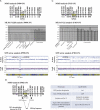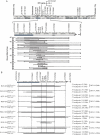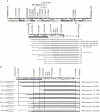Dissecting loss of heterozygosity (LOH) in neurofibromatosis type 1-associated neurofibromas: Importance of copy neutral LOH
- PMID: 21031597
- PMCID: PMC3151547
- DOI: 10.1002/humu.21387
Dissecting loss of heterozygosity (LOH) in neurofibromatosis type 1-associated neurofibromas: Importance of copy neutral LOH
Abstract
Dermal neurofibromas (dNFs) are benign tumors of the peripheral nervous system typically associated with Neurofibromatosis type 1 (NF1) patients. Genes controlling the integrity of the DNA are likely to influence the number of neurofibromas developed because dNFs are caused by somatic mutational inactivation of the NF1 gene, frequently evidenced by loss of heterozygosity (LOH). We performed a comprehensive analysis of the prevalence and mechanisms of LOH in dNFs. Our study included 518 dNFs from 113 patients. LOH was detected in 25% of the dNFs (N = 129). The most frequent mechanism causing LOH was mitotic recombination, which was observed in 62% of LOH-tumors (N = 80), and which does not reduce the number of NF1 gene copies. All events were generated by a single crossover located between the centromere and the NF1 gene, resulting in isodisomy of 17q. LOH due to the loss of the NF1 gene accounted for a 38% of dNFs with LOH (N = 49), with deletions ranging in size from ∼80 kb to ∼8 Mb within 17q. In one tumor we identified the first example of a neurofibroma-associated second-hit type-2 NF1 deletion. Analysis of the prevalence of mechanisms causing LOH in dNFs in individual patients (possibly under genetic control) will elucidate whether there exist interindividual variation.
© 2010 Wiley-Liss, Inc.
Figures





References
-
- Ars E, Serra E, Garcia J, Kruyer H, Gaona A, Lazaro C, Estivill X. Mutations affecting mRNA splicing are the most common molecular defects in patients with neurofibromatosis type 1. Hum Mol Genet. 2000;9:237–247. - PubMed
-
- Bishop AJ, Schiestl RH. Role of homologous recombination in carcinogenesis. Exp Mol Pathol. 2003;74:94–105. - PubMed
-
- Carey JC, Laub JM, Hall BD. Penetrance and variability in neurofibromatosis: a genetic study of 60 families. Birth Defects Orig Artic Ser. 1979;15:271–281. - PubMed
-
- Cavenee WK, Dryja TP, Phillips RA, Benedict WF, Godbout R, Gallie BL, Murphree AL, Strong LC, White RL. Expression of recessive alleles by chromosomal mechanisms in retinoblastoma. Nature. 1983;305:779–784. - PubMed
Publication types
MeSH terms
LinkOut - more resources
Full Text Sources
Research Materials
Miscellaneous

